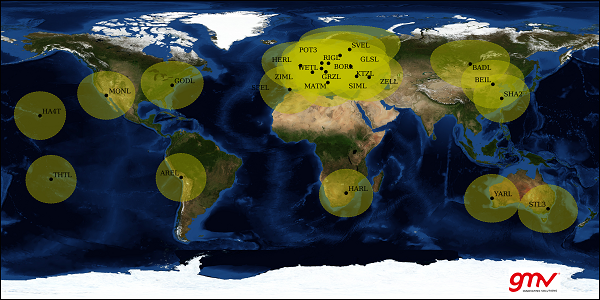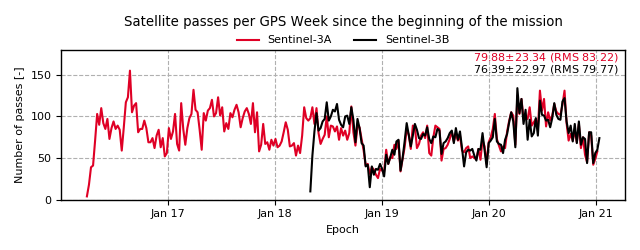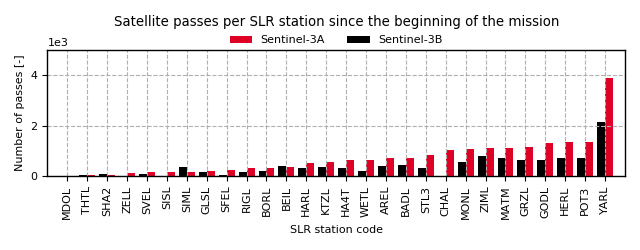Sentinel-3 is equipped with a GPS receiver, a DORIS received and a Laser Retro Reflector (LRR) for Precise Orbit Determination in support of the altimetry mission (see the Satellite Description section for further information). Observations from all three techniques are equally important to fulfil the stringent orbit accuracy requirements of 2-3 cm in radial direction (see the POD Products and Requirements section for further information).
More information on the link between the Copernicus POD Service and the ILRS community is available in the ILRS community section. In this section, we provide up-to-date information on those stations regularly tracking Sentinel-3 as well as a list of CPOD publications involving Sentinel-3 and ILRS.
Due to the sensitivity of the OLCI (Ocean and Land Colour Instrument) to high energy laser illumination, the number of ILSR stations tracking Sentinel-3 was limited to those with an energy threshold below 1.7 nJ/cm2 at the satellite. The list of SLR stations that signed the agreement to track Sentinel-3 satellites following this restriction can be found at the ILRS Sentinel-3: Mission Support page, together with the corresponding Mission Support Request Forms. The geographical location of all SLR stations that are currently tracking both the Sentinel-3A and Sentinel-3B satellites are depicted in the following figure:

Figure 1: Geographical location of the SLR stations tracking Sentinel-3A and Sentinel-3B
Regarding the current tracking statistics for Sentinel-3, the following graphs show the total number of satellite passes since the beginning of the satellite mission per GPS week and per station. From the figures below, it can be seen that the number of satellite passes has recently reached the 100 passes per GPS week meeting similar figures as past years. The SLR station YARL is the one providing more satellite passes for both Sentinel-3 satellites.
Figure 2: Total number of Sentinel-3 passes per GPS week
Figure 3: Total number of Sentinel-3 passes per SLR station
Using the tracking measurements from the SLR stations, an independent orbit validation process has been set up for the precise Sentinel-3 orbital products (AUX_POEORB). Regular comparisons between different processing centres in charge of generating external solutions based on GNSS and DORIS (in the case of CNES solutions) already show a level of agreement below 3 cm in 3D RMS [link to S-3 Quality Control]. Therefore, it is of paramount importance to validate the orbital products independently. The residuals of the SLR measurements with respect to the computed orbit including an azimuth-elevation dependent ranging correction (see the following document for further information) are shown in the Quality Control section.
- J. Fernández, F. Ayuga, P. Féménias, H. Peter. The Copernicus Sentinel-3 mission. ILRS Workshop 2015, Matera, Italy.
- J. Fernández, C. Fernández, P. Féménias, H. Peter. The Copernicus Sentinel-3 Mission POD Service. 20th International Workshop on Laser Ranging. October 9-14 2016, Potsdam, Germany.
- J. Fernández, C. Fernández, E.J. Calero, L. J. Gallardo, H. Peter, P. Féménias. The Copernicus Sentinel-3 Mission. October 2-5, 2017, Riga, Latvia.
- M. Fernández, J. Fernández, H. Peter, P. Féménias. Copernicus Sentinel-3 Mission – Orbit Validation and SLR Station Quality Assessment. ILRS Technical Workshop 2019. October 21-25, 2019, Stuttgart, Germany.
- M. Fernández, J. Berzosa, J. Fernández, H. Peter, P. Féménias. Improved SLR Orbit Validation for Copernicus Sentinel-3 Mission. EGU General Assembly 2020. May 4-8, 2020, online session.
- E. J. Calero, J. Fernández. Sentinel-3 SLR Yearly Report – 2016
- E. J. Calero, J. Fernández. Sentinel-3 SLR Yearly Report – 2017
- M. Fernández, J. Fernández. Sentinel-3 SLR Yearly Report – 2018
- M. Fernández, J. Fernández. Sentinel-3 SLR Yearly Report – 2019

